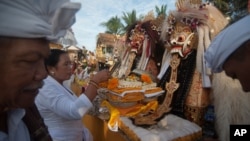Indonesia took a much praised step toward religious tolerance last year by allowing its citizens to list native faiths beyond the six officially recognized religions on their identity cards.
In the early 1960s, Muslim conservatives persuaded the founding president Sukarno to counter mystical sects that they claimed “tarnished” Islam. Followers of the nation’s roughly 245 indigenous faiths gradually left them, leaving only about 200,000 followers of native faiths today in a country of 260 million people.
52 years later, native faiths are poised to make a comeback. They include Javanese kejawen, which combines elements of Java’s Hindu-Buddhist past, folk Islam, Sufi mysticism, and animism. An aim of kejawen practice is discovering batin, the hidden or inner self, through meditation and ritual. The stronghold of kejawen today is Yogyakarta, an ancient sultanate on the southern Javanese coast that has had fierce practitioners even through the decades of suppression.
“What you might call ‘pure kejawen’ has certainly decreased,” said Suwardi Endraswara, a professor at the State University of Yogyakarta. “But kejawen rituals persist, especially in Yogyakarta…because kejawen is ‘endemic’ here: to the forest, the trees, the rivers.”
The Circle
A major way that kejawen is preserved is through spiritual organizations like Sapta Darma and Subud, which was founded in 1920’s Indonesia and now has branches in 83 countries.
Harry Jaran, an artist and hotel manager in Yogyakarta, belongs to one such group, called Pagubayan (or “Circle” of) Hangudi Bawana Tata Lahir Batin, short for a Javanese phrase that means "opening up the world to divine inspiration."
“As soon as the court decision came out last year, I changed my identity card from Muslim to kepercayaan,” said Jaran, using the Indonesian word for “belief” that is sometimes used interchangeably with kejawen. Jaran showed VOA his prayer room, which he painted with a mural of Javanese South Sea goddess, and his meditation garden, with an enormous Buddha statue, at his hotel in northern Yogyakarta. They exemplify the collage aesthetic of kejawen practice.
The Circle meets late on Thursday nights and Friday mornings, “when the border between the spirit and human worlds is thin,” as Jaran explained. They convened under a vast banyan tree in Yogyakarta’s Bantul district just after midnight on a recent Friday. They lit incense, meditated, and took turns bathing in a nearby spring. Wartoyo Sugianto, an old painter and one of the group’s senior members, communicated between the group and their “ancestor spirits” in a high register between a whisper and a laugh.
Lea Indriani, another member of the Circle, is a furniture designer who came to kejawen when she moved to Indonesia as an adult. She is half-Indonesian but grew up in continental Europe.
“Kejawen is not a religion,” she said. “It is universal. Our ancestors would laugh if you ask which religions are correct.” Until the ruling, she had long listed her religion as “Muslim” on her National ID card, under her father’s counsel. “He was thinking of the 1965 killings [of up to 1 million suspected Communists and leftists] and the Christian-Muslim conflict in Maluku in the 1990’s and said, ‘If something happens you need an alibi,’” she said. “I resisted at first, but doctors wouldn’t even treat me if the religion column on my card was blank.” “It looks like things are looking up now for us to practice openly,” she said.
Folk Islam
Most kejawen practitioners have been officially identifying as Muslims on their state ID cards, said Professor Suwardi, and in fact, many still do and see no conflict. But kejawen-tinged folk Islam is highly distinctive.
For instance, at the Mataram cemetery for medieval kings in Yogyakarta’s old town, women cannot enter with a hijab, the Islamic headscarf, even though the late kings and the site itself is fully Muslim. In fact, the splendid, 500-year-old complex includes a large mosque. On Thursday evenings, Javanese Muslims come to the cemetery gates directly after their last prayer at the mosque to light incense and pray over fires, a distinctively [Hindu] Vedic practice.
“This is Javanese Islam,” said Nugroho, one of the cemetery’s hereditary caretakers. “We don’t leave behind the cultures that came before.”
First of many steps
Kejawen has been lucky: although it’s an indigenous faith, it’s the largest indigenous faith in Indonesia and it belongs to Java, the richest and most populous island, and the Javanese, the largest and most powerful ethnic group in Indonesia.
“There are enough superstitions about kejawen that, even in the Suharto era, people let it slide,” said Suwardi.
Smaller native faiths have been hit much harder. Indigenous groups like the Rimba people of the Sumatra jungle are still converting from animism to Islam to get access to social services.
“Slowly, I think we might see a revival in native faiths,” said Harsono. But he warned that the court ruling is not a silver bullet. “Indonesia has already done lasting damage by suppressing these religions for so long… now decades of stigma against their practitioners must be overcome.”





